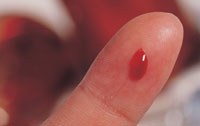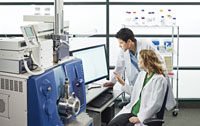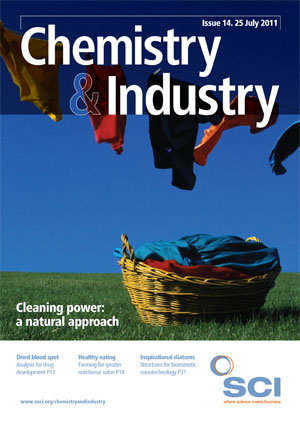Dried blood spot (DBS) sampling has become widely used for screening for a variety of metabolic-related disorders since it was used successfully in the mid-1960s to detect phenylalanine – an indicator for the metabolic disorder phenylketonuria – in new born babies. DBS samples have since been used in diverse applications, most commonly to measure the presence of specific biological proteins, including enzymes, antibodies and nucleic acids, which are indicators for autoimmune diseases, arthritis, thyroid disorders, dengue virus and herpes in adults. DBS sampling is also used for detecting viral proteins in, for example, HIV detection/monitoring, and for therapeutic drug monitoring.
More recently, DBS sampling has been used in drug discovery programmes and preclinical trials, in particular for the quantitative measurement of candidate drug compounds and metabolites in biological samples using liquid chromatography (LC)–mass spectrometry (MS) techniques. Traditionally, this has been done on plasma or serum samples, but DBS samples offer many advantages.
DBS sampling advantages
In DBS sampling, low volume – 10 to 20μL – blood samples are taken from the heel, finger tip, or toe, and ‘spotted’ onto commercially available absorbent cards. The use of small sample volumes has the advantage that it reduces and refines the use of animals in research, and the relative ease with which these samples are obtained means that samples can be taken from children, including new born babies, and from people living in remote areas. Sample storage, handling and transportation are also greatly simplified, with no need for ice, special reagents or bulky laboratory instruments and equipment, all of which can lower costs and, potentially, reduce harmful impacts on the environment. Numerous samples can be stored under normal ambient conditions prior to use, when individual samples are punched out of the card and analysed. DBS samples are also more suitable for measuring compounds that are unstable in aqueous matrices, for example, the major bile metabolite diclofenac acyl glucuronide, which is a useful indicator of intestinal ulcers.
Samples can be analysed using various methods, including ELISA, PCR, protein activity assays and mass spectrometry. Liquid chromatography combined with tandem mass spectrometry (LC–MS–MS) is now routinely used for DBS analysis, providing highly sensitive, fast and reproducible results for small molecules in real time.
Over the years, there have been considerable improvements in LC- and MS-associated technologies, which are helping to make DBSLC– MS–MS a viable option for pharmaceutical studies. The latest triple quadrupole mass spectrometry systems combine high sensitivity and speed on a more versatile platform that integrates quantitative and qualitative analysis. Other important developments include extraction automation, direct desorption and online desorption, which require more straightforward sample preparation and speed-up analyses. Dispersion spray MS, where paper spray is used as a direct sampling ionisation method for analysing complex mixtures, and ultraperformance LC, which provides significantly improved speed and resolution can now be used with DBS. Ions of analyte are generated by applying a high voltage to a paper triangle wetted with a small volume of solution. Samples can be preloaded onto the paper, added with the wetting solution, or transferred from surfaces using the paper as a wipe. Paper spray can be used for analysing a wide variety of compounds, including small organic compounds, peptides and proteins.
Validation studies have demonstrated that DBS-LC–MS–MS assays can achieve similar (or better) levels of sensitivity, selectivity and specificity, when compared with traditional serum sample analyses.
DBS challenges
Despite the many potential benefits of DBS sampling, the switch from traditional plasma or serum sampling to DBS presents several bioanalytical challenges. For example, the small DBS sample size and lack of pre-concentration places increased demands on assay sensitivity, especially for drugs with very low systemic circulation, such as inhaled drugs. Another problem is the assay dynamic range – the range within which the measurement is accurate.


‘By providing technology that offers new breakthrough capabilities, we can help pharmaceutical companies address their needs and push the limits in developing new workflows for DBS anaylsis,’ explained Dave Hicks, vice president and general manager of the pharmaceutical and academic business, AB Sciex.
The high performance of the MS systems, as well as the power of the ultra LC system, also reduces the time needed to conduct analysis, boosting productivity. ‘Recent gains in sensitivity in analytical instrumentation have opened up remarkable new possibilities for pharmaceutical companies to take advantage of dried blood spot analysis,’ said Shane Needham, laboratory director at Alturas Analytics. ‘We have found that using micro-flow HPLC systems gives significantly improved MS signals when analysing drugs. We are now developing these workflows and validating them to ensure they meet our quality assurance requirements.’ As an initial step, AB Sciex scientists have developed a method that allows high sensitivity measurement of inhaled drugs in DBS samples in the low pg/ml range. This method also extends the assay linear range from 3 to 4–5 orders of magnitude, which is necessary to access the pharmacokinetics of limited sensitivity inhaled drugs, particularly those with a short half-life. Alturas scientists are currently investigating the potential of this technique for DBS analysis of pharmaceuticals. They found a clear relationship between the flow rate and the column size – the smaller the column, the greater the increase in MS signal. When analysing 1μL injections of the test compound, propranolol, for example, they discovered over three-fold increases in signal when using 0.5mm ID columns compared with 2.0mm ID. Further validation studies are underway to examine the signal intensity and injection volume effects with 0.3mm ID columns. It will also be important to compare the effects when using real biological samples, and to understand chromatographic and source effects.
In another development within the collaboration, Alturas Analytics has been exploring the application of DBS sampling techniques to other biological matrices, such as urine, plasma, CSF and saliva. Traditionally, spotting of these samples onto DBS cards is problematic because the samples are transparent, making them difficult to see on the card. Alturas scientists have developed a technique, which involves spotting coloured dye onto standard DBS sampling cards. A clear liquid sample, such as CSF, can then be spotted onto the dye spot, displacing the dye – causing a colourless patch to appear within the coloured dye, which indicates the presence and location of the sample. A number of validation studies are underway with these dried matrix spot (DMS) sampling techniques. So far, scientists have shown precise and consistent results with LC–MS–MS analysis of compounds from dried matrix spot (DMS) samples, including synovial fluid, tears and CSF. The accuracy and precision were consistent over time, and showed no matrix effects.
While there is no expectation that DBS will replace all traditional serum or plasma analyses in drug discovery studies, the benefits of this sampling technique combined with the accuracy, precision and sensitivity of modern LC–MS analytical systems could give pharmaceutical companies a major competitive advantage. There is still scope for further improvement in many of the technologies used for DBSLC– MS–MS, such as full automation of manual sample handling – for example, DBS extraction and development of DBS cards that improve ionisation efficiency with direct desorption techniques. Other hurdles to overcome include the problem of volatile, air-sensitive or photosensitive compounds that require special handling in DBS samples, and potential interaction of certain compounds with DBS sample cards.
Johnny Cardenas is manager of global market development at AB Sciex, Framingham, Massachusetts, US.





